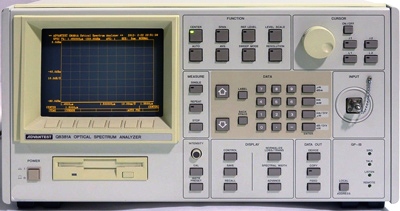
|
|
The Advantest Q8381A optical spectrum analyzer can analyze a wide wavelength band from 350 to 1750 nm and a wide dynamic range from -85 to + 10 dBm (1.1 to 1.6 um), accommodating measurements on display LEDs and optical devices for communication. In addition, Advantest's unique technology realizes low polarization dependence and a high level measurement accuracy of ± 1.5 dB. In addition to the automatic optimum measurement condition setting, automatic peak search and half- value width measurement functions , the Q8381A mounts the pulse light measuring function, power monitoring function and luminosity compensation display functions for improvement of operation and analysis capabilities. In conventional pulse light measurement, even if a number of averagings is made and the average power of duty ratio is obtained; low level and data missing may result. The Q8381A can measure a wide wavelength range from 1.1 to 1.6 um at a high sensitivity of -85 dBm. Therefore, level measurement for spontaneous emission light from an erbium doped fib er amplifier (EDFA) and wavelength characteristic measurement in combination with white light source can be performed over a wide dynamic range. Specifications. Measurement range: 0.35 to 1.75 um. Resolution: 0.1 , 0.2, 0.5, 1.0, 2.0, 5.0 nm. Accuracy: ± 0.5 nm (23 ± 5 C), 1.0 nm (10 to 40 C). Repeatability: 0.1 nm or less (during one-minute repetitive sweep). Measurement range (input sensistivity): -75 to +10 dBm (0.7 to 1.6 um). Level Accuracy: ± 1.5 dB or less (at wavelength of 0.633, 1.31, and 1.55 um). Linearity: ±0.5 dB/ 20 dB or less, ±1.0 dB/ 40 dB or less. Scale: 0.2, 0.5, 1.0, 2.0, 5.0, 10.0 dB/DIVand linear. Measurement time: 0.8 sec or less (with a span of 200 nm or less), 1.5 sec or less (with a span of 500 nm or less).
|